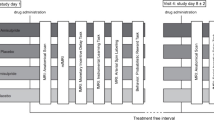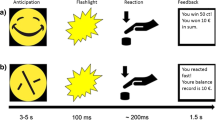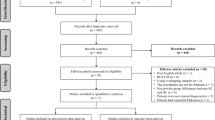Abstract
Rationale
Olanzapine is a neuroleptic drug widely prescribed to treat schizophrenia and bipolar disorder. Although it is long known that modulation of the dopamine system is a basic mechanism of action of neuroleptics, their impact on reward functions mediated by dopamine is still poorly understood.
Objective
Using functional magnetic resonance imaging (fMRI), we intended to reveal the effects of a single dose of olanzapine on reward-related brain activation.
Methods
Eight healthy subjects were each scanned twice, once 5 h after intake of 5 mg of olanzapine and once after intake of placebo in a double-blind cross-over design. Subjects performed a delayed incentive paradigm with monetary reward to investigate reward functions and a breath-holding task as a hypercapnic challenge to reveal unspecific drug effects on the fMRI signal.
Results
Reward-related brain activation in the ventral striatum, anterior cingulate and inferior frontal cortex was reduced on olanzapine compared to placebo. Only the differential effects (high>no reward) in the ventral striatum were independent of overall drug effects as measured with the breath-holding task. Parallel to the differential effects in the ventral striatum, the acceleration of reaction times in the trials with higher rewards was diminished in the olanzapine sessions.
Conclusions
Our behavioural and fMRI results can be interpreted as first evidence from neuroimaging that olanzapine affects the assignment of incentive salience represented by differential activation in dopaminergic brain areas and acceleration of reaction times. This can help to better understand neuroleptic effects in psychiatric diseases. Furthermore, we demonstrate the value of a hypercapnic challenge in functional pharmaco-MRI.




Similar content being viewed by others
References
Abler B, Walter H, Erk S (2005) Neural correlates of frustration. Neuroreport 16:669–672
Abler B, Walter H, Erk S, Kammerer H, Spitzer M (2006) Prediction error as a linear function of reward probability is coded in human nucleus accumbens. Neuroimage 31:790–795
Alex KD, Pehek EA (2006) Pharmacologic mechanisms of serotonergic regulation of dopamine neurotransmission. Pharmacol Ther (in press)
Amenta F, Ricci A, Vega JA (1991) Autoradiographic localization of dopamine receptors in rat cerebral blood vessels. Eur J Pharmacol 192:123–132
Beauducel A, Strobel A, Brocke B (2003) Psychometrische Eigenschaften und Normen einer deutschsprachigen Fassung der Sensation Seeking-Skalen, Form V. Diagnostica 61–72
Brassen S, Tost H, Hoehn F, Weber-Fahr W, Klein S, Braus DF (2003) Haloperidol challenge in healthy male humans: a functional magnetic resonance imaging study. Neurosci Lett 340:193–196
Breiter HC, Gollub RL, Weisskoff RM, Kennedy DN, Makris N, Berke JD, Goodman JM, Kantor HL, Gastfriend DR, Riorden JP, Mathew RT, Rosen BR, Hyman SE (1997) Acute effects of cocaine on human brain activity and emotion. Neuron 19:591–611
Brett M, Valabregue R, Poline J-B (2002) Region of interest analysis using an SPM toolbox. Presented at the 8th international conference on functional mapping of the human brain, Sendai, Japan. Neuroimage 16
Brevard ME, Duong TQ, King JA, Ferris CF (2003) Changes in MRI signal intensity during hypercapnic challenge under conscious and anesthetized conditions. Magn Reson Imaging 21:995–1001
Bymaster FP, Rasmussen K, Calligaro DO, Nelson DL, DeLapp NW, Wong DT, Moore NA (1997) In vitro and in vivo biochemistry of olanzapine: a novel, atypical antipsychotic drug. J Clin Psychiatry 58(Suppl 10):28–36
Cohen MX, Young J, Baek JM, Kessler C, Ranganath C (2005) Individual differences in extraversion and dopamine genetics predict neural reward responses. Brain Res Cogn Brain Res 25:851–861
Cutmore TR, Beninger RJ (1990) Do neuroleptics impair learning in schizophrenic patients? Schizophr Res 3:173–186
Farren CK, Hameedi FA, Rosen MA, Woods S, Jatlow P, Kosten TR (2000) Significant interaction between clozapine and cocaine in cocaine addicts. Drug Alcohol Depend 59:153–163
Galvan A, Hare TA, Davidson M, Spicer J, Glover G, Casey BJ (2005) The role of ventral frontostriatal circuitry in reward-based learning in humans. J Neurosci 25:8650–8656
Howell LL, Wilcox KM, Lindsey KP, Kimmel HL (2006) Olanzapine-induced suppression of cocaine self-administration in rhesus monkeys. Neuropsychopharmacology 31:585–593
Hyman SE (2005) Addiction: a disease of learning and memory. Am J Psychiatry 162:1414–1422
Juckel G, Schlagenhauf F, Koslowski M, Filonov D, Wustenberg T, Villringer A, Knutson B, Kienast T, Gallinat J, Wrase J, Heinz A (2006a) Dysfunction of ventral striatal reward prediction in schizophrenic patients treated with typical, not atypical, neuroleptics. Psychopharmacology (Berl) 187:222–228
Juckel G, Schlagenhauf F, Koslowski M, Wustenberg T, Villringer A, Knutson B, Wrase J, Heinz A (2006b) Dysfunction of ventral striatal reward prediction in schizophrenia. Neuroimage 29:409–416
Kampman KM, Pettinati H, Lynch KG, Sparkman T, O’Brien CP (2003) A pilot trial of olanzapine for the treatment of cocaine dependence. Drug Alcohol Depend 70:265–273
Kapur S (2003) Psychosis as a state of aberrant salience: a framework linking biology, phenomenology, and pharmacology in schizophrenia. Am J Psychiatry 160:13–23
Kapur S, Arenovich T, Agid O, Zipursky R, Lindborg S, Jones B (2005) Evidence for onset of antipsychotic effects within the first 24 hours of treatment. Am J Psychiatry 162:939–946
Kastrup A, Kruger G, Glover GH, Neumann-Haefelin T, Moseley ME (1999) Regional variability of cerebral blood oxygenation response to hypercapnia. Neuroimage 10:675–681
Kirsch P, Schienle A, Stark R, Sammer G, Blecker C, Walter B, Ott U, Burkart J, Vaitl D (2003) Anticipation of reward in a nonaversive differential conditioning paradigm and the brain reward system: an event-related fMRI study. Neuroimage 20:1086–1095
Knutson B, Cooper JC (2005) Functional magnetic resonance imaging of reward prediction. Curr Opin Neurol 18:411–417
Knutson B, Adams CM, Fong GW, Hommer D (2001a) Anticipation of increasing monetary reward selectively recruits nucleus accumbens. J Neurosci 21:RC159
Knutson B, Fong GW, Adams CM, Varner JL, Hommer D (2001b) Dissociation of reward anticipation and outcome with event-related fMRI. Neuroreport 12:3683–3687
Knutson B, Bjork JM, Fong GW, Hommer D, Mattay VS, Weinberger DR (2004) Amphetamine modulates human incentive processing. Neuron 43:261–269
Koch S, Perry KW, Bymaster FP (2004) Brain region and dose effects of an olanzapine/fluoxetine combination on extracellular monoamine concentrations in the rat. Neuropharmacology 46:232–242
Lahti AC, Weiler MA, Medoff DR, Tamminga CA, Holcomb HH (2005) Functional effects of single dose first- and second-generation antipsychotic administration in subjects with schizophrenia. Psychiatry Res 139:19–30
McClure SM, York MK, Montague PR (2004) The neural substrates of reward processing in humans: the modern role of FMRI. Neurosci 10:260–268
Mechanic JA, Wasielewski JA, Carl KL, Holloway FA (2002) Attenuation of the amphetamine discriminative cue in rats with the atypical antipsychotic olanzapine. Pharmacol Biochem Behav 72:767–777
Moore NA, Leander JD, Benvenga MJ, Gleason SD, Shannon H (1997) Behavioral pharmacology of olanzapine: a novel antipsychotic drug. J Clin Psychiatry 58(Suppl 10):37–44
Naber D, Moritz S, Lambert M, Pajonk FG, Holzbach R, Mass R, Andresen B (2001) Improvement of schizophrenic patients’ subjective well-being under atypical antipsychotic drugs. Schizophr Res 50:79–88
O’Doherty JP, Buchanan TW, Seymour B, Dolan RJ (2006) Predictive neural coding of reward preference involves dissociable responses in human ventral midbrain and ventral striatum. Neuron 49:157–166
Potvin S, Stip E, Roy JY (2003) Clozapine, quetiapine and olanzapine among addicted schizophrenic patients: towards testable hypotheses. Int Clin Psychopharmacol 18:121–132
Riecker A, Grodd W, Klose U, Schulz JB, Groschel K, Erb M, Ackermann H, Kastrup A (2003) Relation between regional functional MRI activation and vascular reactivity to carbon dioxide during normal aging. J Cereb Blood Flow Metab 23:565–573
Schmidt K, Nolte-Zenker B, Patzer J, Bauer M, Schmidt LG, Heinz A (2001) Psychopathological correlates of reduced dopamine receptor sensitivity in depression, schizophrenia, and opiate and alcohol dependence. Pharmacopsychiatry 34:66–72
Schultz W (2000) Multiple reward signals in the brain. Nat Rev Neurosci 1:199–207
Schultz W (2001) Reward signaling by dopamine neurons. Neurosci 7:293–302
Schultz W, Tremblay L, Hollerman JR (2000) Reward processing in primate orbitofrontal cortex and basal ganglia. Cereb Cortex 10:272–284
Seeman P (2002) Atypical antipsychotics: mechanism of action. Can J Psychiatry 47:27–38
Spitzer M (1997) A cognitive neuroscience view of schizophrenic thought disorder. Schizophr Bull 23:29–50
Stephan KE, Magnotta VA, White T, Arndt S, Flaum M, O’Leary DS, Andreasen NC (2001) Effects of olanzapine on cerebellar functional connectivity in schizophrenia measured by fMRI during a simple motor task. Psychol Med 31:1065–1078
Tauscher J, Jones C, Remington G, Zipursky RB, Kapur S (2002) Significant dissociation of brain and plasma kinetics with antipsychotics. Mol Psychiatry 7:317–321
Thomason ME, Burrows BE, Gabrieli JD, Glover GH (2005) Breath holding reveals differences in fMRI BOLD signal in children and adults. Neuroimage 25:824–837
Varvel SA, Vann RE, Wise LE, Philibin SD, Porter JH (2002) Effects of antipsychotic drugs on operant responding after acute and repeated administration. Psychopharmacology (Berl) 160:182–191
Volkow ND, Fowler JS, Wang GJ (2004) The addicted human brain viewed in the light of imaging studies: brain circuits and treatment strategies. Neuropharmacology 47(Suppl 1):3–13
Zhang W, Perry KW, Wong DT, Potts BD, Bao J, Tollefson GD, Bymaster FP (2000) Synergistic effects of olanzapine and other antipsychotic agents in combination with fluoxetine on norepinephrine and dopamine release in rat prefrontal cortex. Neuropsychopharmacology 23:250–262
Zink CF, Pagnoni G, Chappelow J, Martin-Skurski M, Berns GS (2006) Human striatal activation reflects degree of stimulus saliency. Neuroimage 29:977–983
Acknowledgment
We declare that the experiments comply with the current laws of the country in which they were performed.
Author information
Authors and Affiliations
Corresponding author
Rights and permissions
About this article
Cite this article
Abler, B., Erk, S. & Walter, H. Human reward system activation is modulated by a single dose of olanzapine in healthy subjects in an event-related, double-blind, placebo-controlled fMRI study. Psychopharmacology 191, 823–833 (2007). https://doi.org/10.1007/s00213-006-0690-y
Received:
Accepted:
Published:
Issue Date:
DOI: https://doi.org/10.1007/s00213-006-0690-y




